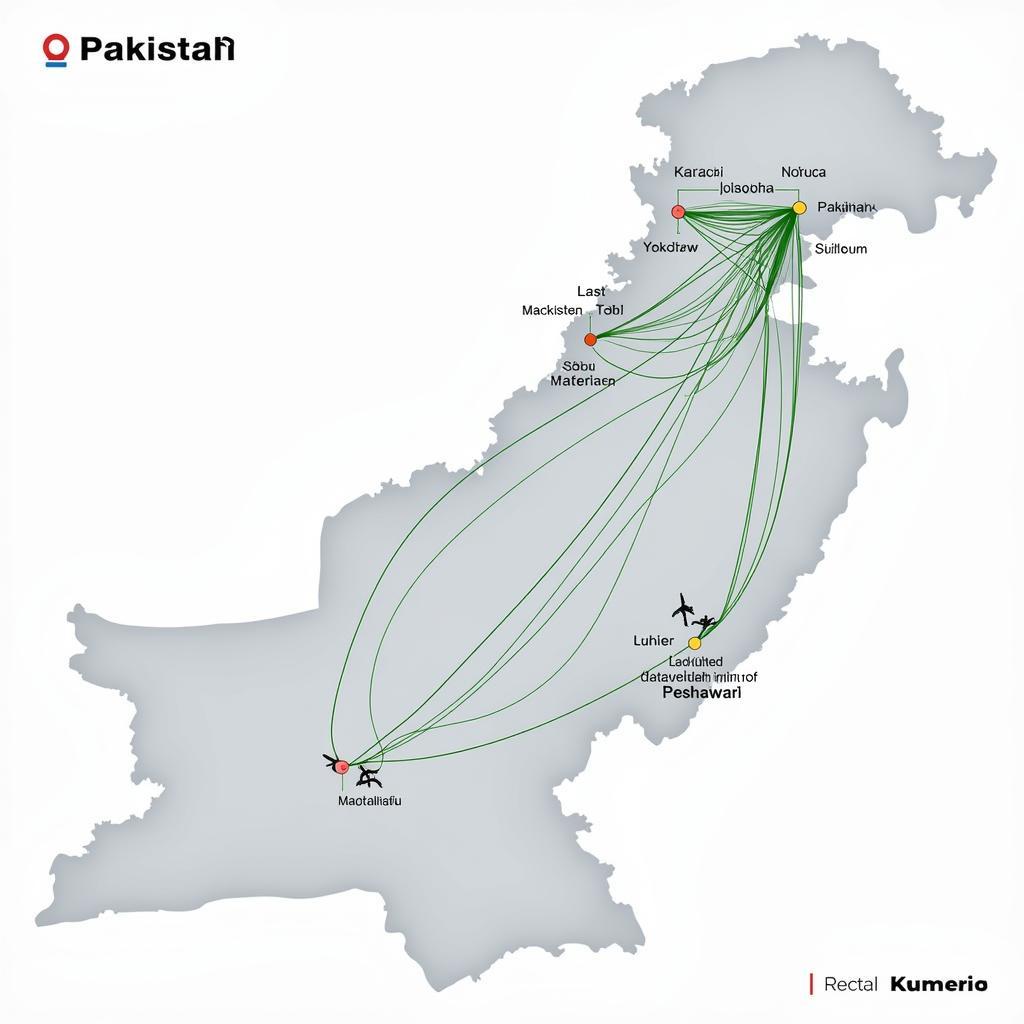The Air Route Map Of Pakistan is a fascinating tapestry woven with threads of domestic and international connections, reflecting the nation’s growing importance in global aviation. This article delves into the complexities of this map, examining its key features, recent developments, and the crucial role it plays in Pakistan’s economic and social landscape.
Understanding the Pakistani Airspace
Pakistan’s airspace is a vital crossroads for air traffic between East and West, serving as a crucial link for numerous airlines. The air route map depicts this bustling activity, showcasing the intricate network of routes that connect major cities within Pakistan and extend outwards to destinations across the globe. This complex system is managed by the Pakistan Civil Aviation Authority (PCAA), responsible for ensuring the safety and efficiency of air travel within the country’s borders. Navigating this airspace requires careful planning and coordination, with air traffic controllers working diligently to manage the flow of aircraft.
The air route map isn’t static; it’s a dynamic entity constantly evolving to accommodate changing traffic patterns and technological advancements. New routes are added, and existing ones are modified to optimize flight paths and reduce travel time. These adjustments reflect the growing demand for air travel within Pakistan and the country’s increasing integration into the global aviation network.
Major Airports and their Connectivity
Pakistan boasts a number of major airports that serve as hubs for both domestic and international flights. Jinnah International Airport in Karachi, Allama Iqbal International Airport in Lahore, and Islamabad International Airport are the primary gateways for international travelers. These airports offer connections to a wide array of destinations worldwide, facilitating trade, tourism, and cultural exchange. From these hubs, smaller airports across the country connect to regional centers, promoting internal connectivity and economic development.
 Major Airports and their Connectivity in Pakistan
Major Airports and their Connectivity in Pakistan
These air routes not only facilitate the movement of people but also play a crucial role in the transportation of goods. Cargo flights are an integral part of the air route map, carrying essential supplies, manufactured products, and agricultural produce across the country and beyond.
The Significance of the Air Route Map for Pakistan’s Economy
The air route map of Pakistan is more than just a visual representation of flight paths. It’s a powerful symbol of the country’s economic progress and its interconnectedness with the world. The aviation sector contributes significantly to Pakistan’s GDP, creating jobs and driving economic growth. The efficient movement of people and goods through the air is essential for trade, tourism, and investment.
For example, convenient pakistan express bus ticket price can be an alternative option for domestic travel within Pakistan.
How the Air Route Map Facilitates Tourism
Tourism is a key sector in Pakistan’s economy, and the air route map plays a vital role in supporting its growth. Easy access to popular tourist destinations through well-established air routes attracts visitors from around the world. This influx of tourists boosts local economies, creates job opportunities, and promotes cultural exchange. It also allows Pakistanis to explore the beauty of their own country with ease. Imagine exploring the historical sites or undertaking a trek to pakistan pdf.
 Impact of Air Routes on Tourism in Pakistan
Impact of Air Routes on Tourism in Pakistan
Knowing the minar e pakistan timing is important for those visiting historical sites.
Future Developments in Pakistan’s Air Network
Pakistan’s air route map is constantly evolving, with ongoing developments aimed at expanding and improving the country’s aviation infrastructure. New airports are being built, and existing ones are being upgraded to accommodate the growing demand for air travel. These investments reflect the government’s commitment to strengthening the aviation sector and its recognition of its importance for economic development. The future of Pakistan’s air network looks bright, with plans to further expand international connections and enhance domestic connectivity. Understanding the blank map of pakistan can help visualize these future developments and expansion plans.
Conclusion
The air route map of Pakistan is a dynamic and vital component of the nation’s infrastructure, connecting its people and businesses to the world. Its ongoing development and expansion play a crucial role in driving economic growth, promoting tourism, and fostering international cooperation. The air route map is not just a chart of flight paths; it is a roadmap for Pakistan’s future. For those planning international travels, knowing the distance between bangladesh and pakistan can be helpful.
FAQ
- What is the main regulatory body for aviation in Pakistan? (The Pakistan Civil Aviation Authority – PCAA)
- Which are the three busiest airports in Pakistan? (Karachi, Lahore, and Islamabad)
- How does the air route map contribute to Pakistan’s economy? (By facilitating trade, tourism, and job creation)
- What are some future developments planned for Pakistan’s air network? (New airport construction and upgrades to existing facilities)
- How does the air route map support tourism in Pakistan? (By providing easy access to popular destinations)
- What information does an air route map provide? (It shows the routes aircraft take between airports, both domestically and internationally)
- How often is the air route map updated? (It is constantly being updated to reflect changes in air traffic, new routes, and other factors)
Need assistance? Contact us 24/7:
Phone: +923337849799
Email: news.pakit@gmail.com
Address: Dera Ghazi Khan Rd, Rakhni, Barkhan, Balochistan, Pakistan.